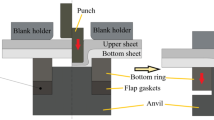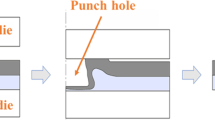Abstract
This article compared the joints produced by clinching (CL), clinch-riveting with rigid rivet (CR) and clinch-riveting with deformable rivet (CD). The effect of rivet on mechanical properties of joints was investigated. The advantages and disadvantages of each joining technique were discussed. The micromorphologies of the failure joints were observed, and the fracture paths of joints were revealed. Two kinds of aluminum alloy (AA1060 and AA5052) were utilized to produce the joints. The mechanical properties of joints were assessed in four aspects: tensile load, shearing load, failure mode and absorbed energy in shearing test. Results showed that the shearing load and absorbed energy of CR and CD joints were much larger than those of CL joint, due to the rivet bore partial shearing load. The presence of rivet did not change the failure mode of joint. All joints failed in the manner of neck fracture. Though the neck thickness of CD joint was a little smaller than that of CR joint, the diameter of neck for CD joint was enlarged by the rivet upsetting. So the neck of CD joint was stronger than that of CR joint. The frictional force and the interlock structure between the rivet and the upper sheet enhanced the tensile load of joint, so the static load of CD joint was the largest, the CR joint ranked second, and the CL joint ranked last.




















Similar content being viewed by others
References
Guo FB, Zhu BH, Jin LB, Wang GJ, Yan HW, Li ZH, Zhang YA, Xiong BQ (2017) Microstructure and mechanical properties of 7A56 aluminum alloy after solution treatment. Rare Metals 40(1):168–175. https://doi.org/10.1007/s12598-017-0985-7
Huang G, Li ZH, Sun LM, Li XW, Wen K, Yan LZ, Xiong BQ, Zhang YA (2020) Fatigue crack growth behavior of 2624–T39 aluminum alloy with different grain sizes. Rare Metals 40(9):2523–2529. https://doi.org/10.1007/s12598-020-01496-0
Atia MKS, Jain MK (2018) Finite element analysis of material flow in die-less clinching process and joint strength assessment. Thin-Walled Struct 127:500–515. https://doi.org/10.1016/j.tws.2018.03.001
Ran X, Chen C, Zhang H, Ouyang Y (2021) Investigation of the clinching process with rectangle punch. Thin-Walled Struct 166:108034. https://doi.org/10.1016/j.tws.2021.108034
Chen C, Li Y, Zhai Z, Zhao S, Zhang P, Huang M, Li Y (2019) Comparative investigation of three different reforming processes for clinched joint to increase joining strength. J Manuf Process 45:83–91. https://doi.org/10.1016/j.jmapro.2019.06.009
Peng H, Chen C, Li H, Gao X (2021) Joining thin-walled structures without protuberance by two-strokes flattening clinching process. Int J Adv Manuf Technol 116(3–4):1213–1223. https://doi.org/10.1007/s00170-021-07517-1
Peng H, Chen C, Ren X, Ran X, Gao X (2021) Research on the material flow and joining performance of two-strokes flattening clinched joint. Thin-Walled Struct 169:108289. https://doi.org/10.1016/j.tws.2021.108289
Ren X-q, Chen C, Ran X-k, Li Y-x, Zhang X-g (2021) Microstructure evolution of AA5052 joint failure process and mechanical performance after reconditioning with tubular rivet. Trans Nonferrous Met Soc China 31(11):3380–3393. https://doi.org/10.1016/s1003-6326(21)65736-9
Chen C, Zhang H, Qin D, Li H (2021) Joining different aluminum alloy sheets by flat clinching process. Int J Adv Manuf Technol 116(3–4):1071–1079. https://doi.org/10.1007/s00170-021-07511-7
Chen C, Zhang H, Ren X, Wu J (2021) Investigation of flat-clinching process using various thicknesses aluminum alloy sheets. Int J Adv Manuf Technol 114(7–8):2075–2084. https://doi.org/10.1007/s00170-021-06981-z
Chen C, Wu J, Li H (2021) Optimization design of cylindrical rivet in flat bottom riveting. Thin-Walled Struct 168:108292. https://doi.org/10.1016/j.tws.2021.108292
Paidar M, Mehrez S, Babaei B, Memon S, Ojo OO, Lankarani HM (2021) Dissimilar welding of AA5083 to AZ31 Mg alloys using modified friction stir clinching brazing. Mater Lett 301:129764. https://doi.org/10.1016/j.matlet.2021.129764
Paidar M, Elveny M, Mehrez S, Ravi S, Babaei B, Ravichandran M (2021) Influence of material positioning during modified friction stir clinching brazing of Al/Zn/Cu welds. Mater Lett 301:130250. https://doi.org/10.1016/j.matlet.2021.130250
Tong L, Xie J, Liu L, Chang G, Ojo OO (2020) Microscopic appraisal and mechanical behavior of hybrid Cu/Al joints fabricated via friction stir spot welding-brazing and modified friction stir clinching-brazing. J Mater Res Technol 9(6):13239–13249. https://doi.org/10.1016/j.jmrt.2020.09.042
Durandet Y, Deam R, Beer A, Song W, Blacket S (2010) Laser assisted self-pierce riveting of AZ31 magnesium alloy strips. Mater Des 31:S13–S16. https://doi.org/10.1016/j.matdes.2009.10.038
Wang J, Zhang G, Zheng X, Li J, Li X, Zhu W, Yanagimoto J (2021) A self-piercing riveting method for joining of continuous carbon fiber reinforced composite and aluminum alloy sheets. Compos Struct 259:113219. https://doi.org/10.1016/j.compstruct.2020.113219
Ma Y, Shan H, Niu S, Li Y, Lin Z, Ma N (2021) A Comparative study of friction self-piercing riveting and self-piercing riveting of aluminum alloy AA5182-O. Engineering 7(12):1741–1750. https://doi.org/10.1016/j.eng.2020.06.015
Xing B, Tang F, Song C, He X (2021) Static and fatigue behavior of self-piercing riveted joints with two overlap areas. J Mater Res Technol 14:1333–1338. https://doi.org/10.1016/j.jmrt.2021.07.064
Calabrese L, Bonaccorsi L, Proverbio E, Di Bella G, Borsellino C (2013) Durability on alternate immersion test of self-piercing riveting aluminium joint. Mater Des 46:849–856. https://doi.org/10.1016/j.matdes.2012.11.016
Zhang X, He X, Gu F, Ball A (2019) Self-piercing riveting of aluminium–lithium alloy sheet materials. J Mater Process Technol 268:192–200. https://doi.org/10.1016/j.jmatprotec.2019.01.019
Zhang X, He X, Xing B, Wei W, Lu J (2020) Pre-holed self-piercing riveting of carbon fibre reinforced polymer laminates and commercially pure titanium sheets. J Mater Process Technol 279:116550. https://doi.org/10.1016/j.jmatprotec.2019.116550
Liang J, Jiang H, Zhang J, Wu X, Zhang X, Li G, Cui J (2019) Investigations on mechanical properties and microtopography of electromagnetic self-piercing riveted joints with carbon fiber reinforced plastics/aluminum alloy 5052. Arch Civ Mech Eng 19(1):240–250. https://doi.org/10.1016/j.acme.2018.11.001
Jiang H, Gao S, Li G, Cui J (2019) Structural design of half hollow rivet for electromagnetic self-piercing riveting process of dissimilar materials. Mater Des 183:108141. https://doi.org/10.1016/j.matdes.2019.108141
Jiang H, Sun LQ, Liang JS, Li GY, Cui JJ (2019) Shear failure behavior of CFRP/Al and steel/Al electromagnetic self-piercing riveted joints subject to high-speed loading. Compos Struct 230:111500. https://doi.org/10.1016/j.compstruct.2019.111500
Mucha J, Kaščák Lu, Spišák E (2013) The experimental analysis of forming and strength of clinch riveting sheet metal joint made of different materials. Adv Mech Eng 5:848973. https://doi.org/10.1155/2013/848973
Acknowledgements
This research work is supported by the National Natural Science Foundation of China (Grant No. 51805416), Young Elite Scientists Sponsorship Program by CAST (Grant No. 2019QNRC001), Hunan Provincial Natural Science Foundation for Excellent Young Scholars (Grant No. 2021JJ20059), the Project of State Key Laboratory of High Performance Complex Manufacturing, Central South University (Grant No. ZZYJKT2022-01), and Huxiang High-Level Talent Gathering Project of Hunan Province (Grant No. 2019RS1002).
Author information
Authors and Affiliations
Corresponding author
Ethics declarations
Conflict of interest
The authors declare that they have no conflict of interest.
Additional information
Technical Editor: Lincoln Cardoso Brandao.
Publisher's Note
Springer Nature remains neutral with regard to jurisdictional claims in published maps and institutional affiliations.
Rights and permissions
About this article
Cite this article
Wu, J., Chen, C. Comparative study of the clinching process and clinch-riveting process. J Braz. Soc. Mech. Sci. Eng. 44, 336 (2022). https://doi.org/10.1007/s40430-022-03626-4
Received:
Accepted:
Published:
DOI: https://doi.org/10.1007/s40430-022-03626-4




